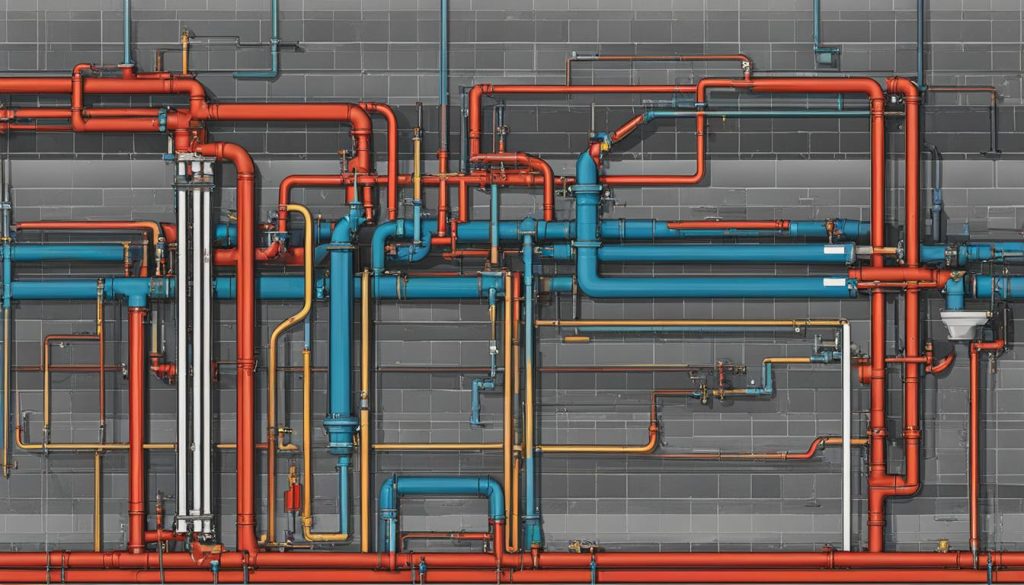Understanding Plumbing Riser Diagrams Explained
Did you know that plumbing riser diagrams are essential blueprints for the efficient functioning of a building’s water supply and waste lines? These technical representations provide a clear visual of the pipe routes across different levels of a structure, ensuring seamless water flow and preventing costly malfunctions.
Plumbing riser diagrams outline crucial information such as pipe sizes, material specifications, and connection types. Architects, builders, and plumbers rely on these diagrams during construction and engineering projects to anticipate potential issues, ensure code compliance, and facilitate collaboration among contractors.
Whether it’s for new construction or renovations, a correctly interpreted plumbing riser diagram holds the key to a building’s plumbing network’s functionality and efficiency, saving both time and money in the long run.
Key Takeaways:
- Plumbing riser diagrams are vital in ensuring the proper functioning and longevity of a building’s plumbing system.
- They provide a visual representation of the pipe routes and essential information for installation and maintenance.
- Plumbing riser diagrams facilitate collaboration among architects, builders, and plumbers in construction projects.
- A well-planned plumbing riser diagram prevents costly malfunctions and promotes robust infrastructure.
- These diagrams are crucial for compliance with codes and standards and guide efficient building design.
The Art of Plumbing Riser Diagrams
Plumbing riser diagrams are intricate art forms that demonstrate the path of pipes within a structure. They use precise symbols and labels to guide the installation process and preempt potential conflicts with other systems. Each diagram details the vertical rise of plumbing lines, illustrating how water moves from source to endpoint.
The layout of these diagrams is designed to be accessible and comprehensive, often accounting for multiple floors in a single drawing. Clean layouts, consistent symbols, and color-coding enhance the readability and effectiveness of the diagrams. Plumbing riser diagrams also incorporate regulations and standards for pipe dimensions, materials, and placement.
They serve as historical documents, providing reference points for maintenance, renovations, and expansions. These diagrams are crucial for ensuring the proper functioning and longevity of a building’s plumbing system. There are also various software options available to create and interpret plumbing riser diagrams.
Symbols Used in Plumbing Riser Diagrams:
To effectively interpret plumbing riser diagrams, it’s essential to understand the symbols used to represent different components. Here are some common symbols:
| Symbol | Description |
|---|---|
| Symbol 1 description | |
| Symbol 2 description | |
| Symbol 3 description |
These symbols, when combined with clear labels and legends, create a visual language that plumbers and professionals can easily understand and follow for accurate installation and maintenance.
How to Read a Plumbing Riser Diagram?
Reading a plumbing riser diagram requires familiarity with the symbols used and an understanding of the vertical layout. Here are some steps to help you read a plumbing riser diagram:
- Start by identifying the water source. This is typically represented by a labeled symbol or icon.
- Follow the flow of water vertically, tracing the path from the source to the endpoints.
- Pay attention to symbols representing different components like valves, pumps, and fixtures.
- Refer to the legends and labels for further clarification on the symbols used.
By following these steps and familiarizing oneself with the symbols, anyone can effectively read and understand a plumbing riser diagram.
The Backbone of Efficient Building Design
Plumbing riser diagrams play a crucial role in the architecture and engineering of buildings. They serve as the structural blueprint, outlining the network of water flow that supports the building’s plumbing system. These diagrams are essential tools that guide plumbers in placing pipes, selecting the appropriate types and connections, and ensuring efficiency and practicality during the installation process.
For residential buildings, plumbing riser diagrams show the layout of hot and cold water lines, ensuring proper distribution throughout the house. In commercial buildings, they may include additional systems like fire sprinklers, which require detailed planning and integration with the plumbing system.
Designing a plumbing riser diagram involves careful consideration of various factors, including the size and capacity of pipes, the location of fixtures, and compliance with local codes and standards. By integrating the abstract design with concrete execution, these diagrams prevent wasted space, budget overruns, and design complications.
Compliance with local codes and standards is of paramount importance in plumbing riser diagrams. Safety, sustainability, and reliability of the water system are ensured by adhering to these regulations.
Whether it’s a residential or commercial building, a well-planned plumbing riser diagram is essential for efficient building design.
The Benefits of Plumbing Riser Diagrams:
- Clear visualization of the plumbing system’s structure
- Guidance for plumbers during the installation process
- Prevention of wasted space, budget overruns, and design complications
- Integration with other building systems like fire sprinklers
- Compliance with local codes and standards for safety and reliability
Navigating the Verticals: Understanding Plumbing Riser Diagrams
Plumbing riser diagrams play a crucial role in understanding the intricate vertical pathways of pipes within multi-story buildings. These diagrams serve as detailed maps that provide a clear visualization of how water travels up and down floors, ensuring the needs of the building’s inhabitants are met.
When examining a plumbing riser diagram, it’s important to pay attention to the details. The diagram will showcase essential information such as pipe sizes, materials, and connection types that are necessary for a properly functioning water system. Additionally, isolation valves and access panels may also be displayed to facilitate future maintenance.
Architects rely on plumbing riser diagrams to convert their visions into functional layouts, while plumbers use them as a guide for accurate installation. Through the incorporation of rules and regulations, plumbing riser diagrams ensure compliance with safety and building codes, preventing errors and upholding building integrity. These diagrams are instrumental in guaranteeing reliable water services on every floor.
Reading a Plumbing Riser Diagram
Reading a plumbing riser diagram may seem daunting at first, but with some basic knowledge, it can become an indispensable skill. Here are a few key steps to help you navigate and interpret a plumbing riser diagram:
- Start by familiarizing yourself with the symbols used in the diagram. Each symbol represents a specific component or feature of the plumbing system.
- Identify the different pipes shown in the diagram, paying attention to their sizes and materials. This information is crucial for understanding the flow and capacity of the water system.
- Take note of the connection types displayed in the diagram. This will help you understand how the pipes are joined together and ensure proper installation.
- Observe the presence of isolation valves and access panels. These components are essential for future maintenance and troubleshooting.
- Pay attention to any labels or additional information provided in the diagram. This might include details about fixtures, appliances, or other components that are connected to the plumbing system.
By following these steps, you’ll be able to decipher the key elements of a plumbing riser diagram and gain a better understanding of how the building’s plumbing system functions.
Riser Diagrams for Water Supply
Riser diagrams for water supply play a crucial role in designing and understanding the distribution of hot and cold water lines within a building. These diagrams provide a visual representation of the layout, ensuring efficient water flow and compliance with regulations. Unlike waste pipes, water supply riser diagrams offer more design flexibility as they are not connected to drains and vents.
One of the key purposes of these diagrams is to ensure that the correct pipe sizes are selected, taking into account peak demand conditions. The minimum size of the fixture supply pipe can vary depending on the specific fixture being supplied. For instance, larger pipe sizes are required for bathtubs, kitchen sinks, and toilets with flush valves.
Another important aspect depicted in these diagrams is the inclusion of various backflow preventers. These preventers are essential in protecting the potable water supply from potential contamination, guaranteeing the safety and quality of the water being distributed throughout the building.
Overall, riser diagrams for water supply provide a thorough understanding of the water distribution system within a building. They ensure that the plumbing infrastructure is efficient, reliable, and compliant with regulations, resulting in a functional and safe water supply for residents and occupants.
Example Riser Diagram for Water Supply:
| Fixture | Fixture Supply Pipe Size (inches) |
|---|---|
| Kitchen Sink | 0.75 |
| Bathtub | 1 |
| Toilet with Flush Valve | 1.5 |
Riser Diagrams for Stacks
Riser diagrams for stacks play a vital role in maintaining the integrity of a building’s plumbing system. These diagrams provide a visual representation of the vertical pipes that make up the plumbing system, including sanitary, storm, and vent piping. The sanitary piping carries sewage, while storm piping handles storm water and groundwater. Vent piping provides airflow to or from drainage systems. By illustrating the various components of the stack system, such as stack vents, vent stacks, and trap vents, these diagrams ensure that the plumbing system functions properly and prevent the emission of sewer gases.
Plumbers use larger pipes for these stacks to accommodate the volume of waste and prevent contamination of potable water. It’s crucial to maintain the separation between water supply pipes and drainage pipes, and riser diagrams for stacks illustrate the necessary distances and connections. These diagrams facilitate effective planning, installation, and maintenance of the plumbing system, helping prevent issues and ensuring the system operates efficiently.
| Component | Description |
|---|---|
| Sanitary Piping | Carries sewage |
| Storm Piping | Handles storm water and groundwater |
| Vent Piping | Provides airflow to or from drainage systems |
| Stack Vents | Allow air to enter or exit the stack system |
| Vent Stacks | Extend vertically to release sewer gases |
| Trap Vents | Prevent sewer gases from entering the building |
As you can see, riser diagrams for stacks help ensure the proper functioning of a building’s plumbing system by providing a comprehensive overview of the vertical pipes and their components. Investing in a well-designed and accurately interpreted riser diagram for stacks is crucial for maintaining a reliable and efficient plumbing system.
Risers for Sprinklers
Risers for sprinklers play a crucial role in ensuring the safety of commercial buildings equipped with fire sprinkler systems. As an integral component, these systems must be carefully designed and installed, and their inclusion in the plumbing riser diagram is essential. In addition to potable water, non-potable water used for fire sprinklers needs to be identified and appropriately labeled within the diagram.
Designing a plumbing riser diagram for sprinkler systems requires adherence to specific standards and regulations. By incorporating these requirements into the overall plumbing system, riser diagrams facilitate the coordination and integration of fire safety features. This comprehensive approach ensures that the plumbing infrastructure not only delivers water efficiently but also provides robust protection against fire hazards.
With their ability to safeguard lives and protect property, risers for sprinklers are vital in emergency situations. By accurately representing sprinkler systems in the plumbing riser diagram, architects, builders, and plumbers can collaborate effectively to create buildings that prioritize safety and adhere to code compliance, reinforcing peace of mind for occupants and stakeholders alike.
- Investing Wisely: How Windows & Doors in Boost Property Value and Financial Health - April 24, 2025
- The Financial Impact of Personal Injuries: Why Legal Help Matters for Business Owners - April 16, 2025
- The Hidden Financial Costs of Domestic Assault: What Business Owners Need to Know - April 16, 2025













